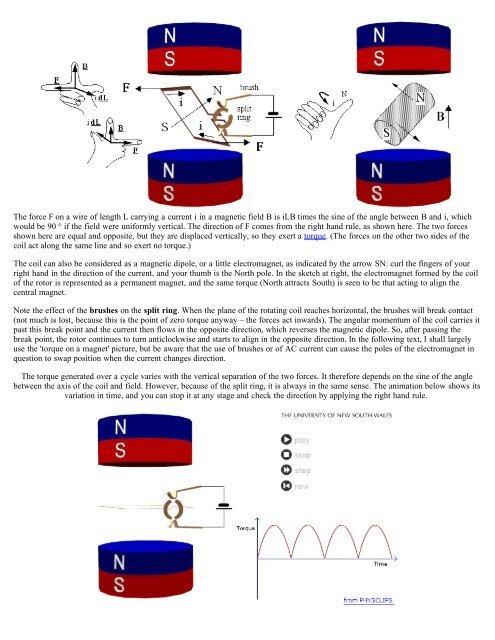How real electric motors work - School of Physics - The University of ...
How real electric motors work - School of Physics - The University of ...
How real electric motors work - School of Physics - The University of ...
You also want an ePaper? Increase the reach of your titles
YUMPU automatically turns print PDFs into web optimized ePapers that Google loves.
<strong>The</strong> force F on a wire <strong>of</strong> length L carrying a current i in a magnetic field B is iLB times the sine <strong>of</strong> the angle between B and i, which<br />
would be 90 ° if the field were uniformly vertical. <strong>The</strong> direction <strong>of</strong> F comes from the right hand rule, as shown here. <strong>The</strong> two forces<br />
shown here are equal and opposite, but they are displaced vertically, so they exert a torque. (<strong>The</strong> forces on the other two sides <strong>of</strong> the<br />
coil act along the same line and so exert no torque.)<br />
<strong>The</strong> coil can also be considered as a magnetic dipole, or a little electromagnet, as indicated by the arrow SN: curl the fingers <strong>of</strong> your<br />
right hand in the direction <strong>of</strong> the current, and your thumb is the North pole. In the sketch at right, the electromagnet formed by the coil<br />
<strong>of</strong> the rotor is represented as a permanent magnet, and the same torque (North attracts South) is seen to be that acting to align the<br />
central magnet.<br />
Note the effect <strong>of</strong> the brushes on the split ring. When the plane <strong>of</strong> the rotating coil reaches horizontal, the brushes will break contact<br />
(not much is lost, because this is the point <strong>of</strong> zero torque anyway – the forces act inwards). <strong>The</strong> angular momentum <strong>of</strong> the coil carries it<br />
past this break point and the current then flows in the opposite direction, which reverses the magnetic dipole. So, after passing the<br />
break point, the rotor continues to turn anticlockwise and starts to align in the opposite direction. In the following text, I shall largely<br />
use the 'torque on a magnet' picture, but be aware that the use <strong>of</strong> brushes or <strong>of</strong> AC current can cause the poles <strong>of</strong> the electromagnet in<br />
question to swap position when the current changes direction.<br />
<strong>The</strong> torque generated over a cycle varies with the vertical separation <strong>of</strong> the two forces. It therefore depends on the sine <strong>of</strong> the angle<br />
between the axis <strong>of</strong> the coil and field. <strong>How</strong>ever, because <strong>of</strong> the split ring, it is always in the same sense. <strong>The</strong> animation below shows its<br />
variation in time, and you can stop it at any stage and check the direction by applying the right hand rule.
















